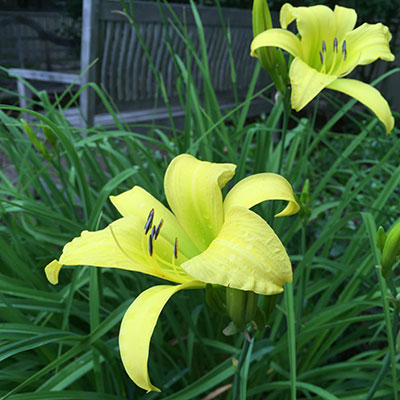






A variety called Hyperion
IF there's a "sure bet" perennial, it must be the daylily. They thrive from Minnesota to Florida (zones 3 to 9), tolerate a wide variety of soil conditions, are not troubled by diseases or pests, and bloom faithfully for years with virtually no attention. The daylily's botanical name, Hemerocallis, means "beauty for a day", and indeed most daylily flowers open in the morning and die by nightfall. However, each flower stem (also called a scape) typically has at least a dozen flower buds, so the plant stays in bloom for several weeks.
Unlike most perennials, daylilies are well-suited to many different uses in the garden and landscape. The shorter, more compact varieties work well planted directly into perennial borders, where their blooms provide a welcome mid-summer boost. In groups of 3 or 5, daylilies are ideal for landscape plantings, especially when paired with ornamental grasses and small shrubs. Daylilies are also the perfect plant for mass plantings along a fence or walkway, where they'll form a dense, weed-proof display.
There are several different species of daylilies, including the ubiquitous roadside lily (Hemerocallis fulva), the night-blooming Hemerocallis citrina, and the fragrant lemon lily (Hemerocallis flava). Most of the daylilies planted by home gardeners are hybrid cultivars.
Flower breeders have had a field day with daylilies and there are now thousands of named cultivars. These cultivars can be grouped in a variety of ways: by bloom time (early, mid-, and late), flower color (white to yellow, pink and purple), scape height (6 inches to 3 feet tall), and flower form (trumpet, double, ruffled, recurved).
By choosing early-, mid-, and late-flowering cultivars, you can have daylily flowers blooming through most of the summer. If you also mix various heights, flower colors, and flower shapes, you can enjoy new and different flowers each day. Professional horticulturists separate daylilies into several additional categories. Here are some of the terms you may encounter:
Diploid: These cultivars have 22 chromosomes in the plant. They tend to have more numerous, but smaller flowers than tetraploids, and a graceful, old-fashioned form. Many double-flowered daylilies are diploids.
Tetraploid: These daylilies have 44 chromosomes. Tetraploid daylilies tend to have larger, more intensely colored flowers than diploids. They're also supported by stronger, sturdier scapes.
Miniature: These compact varieties range from 12 to 25 inches tall. Flowers are smaller, too. They're excellent for small spaces and for planting directly in the perennial border.
Dormant: The foliage of these cultivars dies back to the ground in fall regardless of the weather. These cultivars grow best in cold climates. Most daylily cultivars fall in this category.
Evergreen/Semi-Evergreen: Some daylilies have foliage that stays evergreen or semi-evergreen all winter in mild areas. These cultivars are best adapted to warm-climate areas.
Reblooming: Some daylily cultivars will bloom a number of times during the summer. In general, daylilies have a main bloom period in summer, followed by intermittent blooms, often right up until frost. Removing the faded flower heads encourages reblooming.
Daylilies flower best when planted in full sun (6 hours/day), on moist, yet well-drained soil. In hot climates, dark-colored cultivars should receive some afternoon shade to help them retain their flower color. When planted in the correct location, daylilies will flower for years with little care. They do not require fertilization other than a yearly addition of compost.
If buying daylilies by mail, plant them within a few days of receiving them. In the South, plant in spring or fall while temperatures are still cool. In the North, daylilies should be planted in spring so they have plenty of time to get established before winter. However, daylilies are such tough plants, that in the North, most can be planted anytime from spring through fall.
Amend the soil with compost before planting. Space plants 12 to 18 inches apart and plant so the crown is about 1 inch below the soil surface. Water well and mulch with bark or straw to conserve moisture and prevent weeds from growing. Although resilient once established, young transplants should be kept free from weeds and well watered the first year.
Daylilies have few pests. However, a new daylily disease--a type of rust--has been spreading throughout the county, attacking many plants. To control this disease, keep the area around daylilies open and airy, remove diseased foliage, and water plants when rainfall is insufficient.
One of the few routine maintenance chores needed when growing daylilies is dividing them. Depending on their growth, your daylily clump will usually become crowded after four to five years and flowering will diminish. In most areas, late summer is the best time to divide daylilies. In the North, early spring is an alternate option, especially if the weather typically turns cold quickly in fall.
Dig up individual clumps and put them on a tarp. Use a sharp knife or spade to separate healthy young plants (fans) with strong root systems. Cut back the foliage and replant immediately in compost-amended soil or plant in containers for holding. You'll have many extra plants from each clump to give away to friends and neighbors. Discard any small or diseased plants.
In northern areas, newly planted daylilies can be mulched in late fall. This is important for young plants which otherwise may be heaved out of the ground the first winter. Dead foliage can be removed in spring, unless it was diseased. In that case it is best to remove it in fall.
Copyright © www.100flowers.win Botanic Garden All Rights Reserved